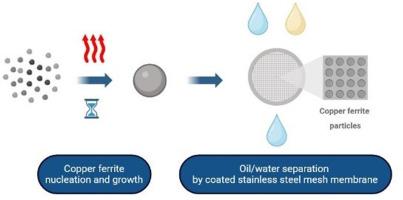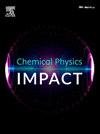铁氧体铜涂层网膜的非混相液体分离:基于中心复合统计设计的生长优化
IF 4.3
Q2 CHEMISTRY, PHYSICAL
引用次数: 0
摘要
油水分离是一项严峻的环境和工业挑战,因为石油泄漏和含油废水排放会造成严重的生态破坏和资源损失。传统的分离方法往往存在效率低、操作成本高、分离介质可重复使用性差等局限性。在本研究中,通过水热辅助生长工艺制备了一种带有氧化铜种子层和微/纳米结构铁氧体铜涂层的不锈钢网状膜。采用中心复合设计(CCD)确定了最佳合成参数为:生长时间11 h 30 min,煅烧温度727℃,氨含量0.54 mol。X射线衍射(XRD)证实形成了立方尖晶石CuFe2O₄相,含有少量氧化物杂质,而场发射扫描电镜(FESEM)显示出均匀的纳米棒形貌,表面粗糙度增强。能量色散X射线能谱(EDS)和元素映射显示Cu、Fe和O的均匀分布,Cu:Fe原子比接近1:2,振动样品磁强计(VSM)显示铁磁性。表面能分析显示其极性成分占主导地位,色散贡献可以忽略不计,因此具有较强的亲水性和水下疏油性。优化后的膜水通量为37,037 L m(⁻²h),分离效率为99.9%以上,水下油接触角为146°±3.55°,在10次循环使用中性能稳定。机械磨损和化学暴露测试证实了在酸性、碱性和盐水条件下的耐久性。与之前报道的膜相比,CCD优化的铁氧体铜涂层独特地将机械弹性、化学坚固性和长期可重复使用性集成到一个高性能平台中,可在苛刻的环境中实现高效的油水分离。本文章由计算机程序翻译,如有差异,请以英文原文为准。

Immiscible liquids separation by copper ferrite coated mesh membranes: central composite statistical design-based growth optimization
Oil/water separation is a critical environmental and industrial challenge, as oil spills and oily wastewater discharge cause severe ecological damage and resource loss. Conventional separation methods often face limitations such as low efficiency, high operational cost, and poor reusability of separation media. In this study, a stainless steel mesh membrane with a copper oxide seed layer and a micro/nano‑structured copper ferrite coating was fabricated via a hydrothermal‑assisted growth process. The optimal synthesis parameters, determined using a central composite design (CCD), were a growth time of 11 h and 30 min, calcination temperature of 727 °C, and ammonia content of 0.54 mol. X‑ray diffraction (XRD) confirmed the formation of a cubic spinel CuFe2O₄ phase with minor oxide impurities, while field‑emission scanning electron microscopy (FESEM) revealed a uniform nanorod morphology with enhanced surface roughness. Energy‑dispersive X‑ray spectroscopy (EDS) and elemental mapping showed a homogeneous distribution of Cu, Fe, and O with a Cu:Fe atomic ratio close to 1:2, and vibrating‑sample magnetometry (VSM) indicated ferromagnetic behavior. Surface energy analysis revealed a dominant polar component and negligible dispersive contribution, resulting in strong hydrophilicity and underwater oleophobicity. The optimized membrane achieved a water flux of 37,037 L m⁻² h⁻¹, a separation efficiency above 99.9 %, and an underwater oil contact angle of 146°±3.55° maintaining stable performance over ten reuse cycles. Mechanical abrasion and chemical exposure tests confirmed durability under acidic, alkaline, and saline conditions. Compared to previously reported membranes, the CCD‑optimized copper ferrite coating uniquely integrates mechanical resilience, chemical robustness, and long‑term reusability into a single high‑performance platform for efficient oil/water separation in demanding environments.
求助全文
通过发布文献求助,成功后即可免费获取论文全文。
去求助
来源期刊

Chemical Physics Impact
Materials Science-Materials Science (miscellaneous)
CiteScore
2.60
自引率
0.00%
发文量
65
审稿时长
46 days
 求助内容:
求助内容: 应助结果提醒方式:
应助结果提醒方式:


